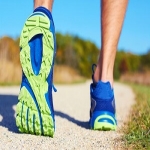
The New Year is upon us and you have decided that you are going to begin working out. Would you want to take up tennis, golf or running? Perhaps you enjoy hiking? Well, you will need the proper shoes to proceed.
The American Academy of Orthopedic Surgeons lists 7 different categories of shoes for exercising.
- Running
- Barefoot running shoes
- Cross trainers
- Walking Shoes
- Court Shoes
- Cleats
- Hiking Shoes
There are other Sports Shoes that do not fall into these categories such as sports specific shoes like golf, ballet, ice skating, etc.
Are you wearing the right type of shoes when you work out?
Running Shoes
Typically running shoes are lighter and more breathable with extra cushion in the heel. When running some people may tend to supinate (meaning turning foot inward) or pronate (outward) which would alter the wear on the sole of the shoes. If you are planning on running, the best way to determine what type of shoe is right for you is to have a professional evaluate you. There are several places in the metro area that are equipped for this.
Barefoot Running Shoes
These shoes are becoming more popular. It is important if you choose these shoes to transition slowly and pay very close attention to your symptoms. There has been studies that have shown increased risk of injury with wearing a minimalist shoe
Cross Trainers
These types of shoes are one of the more diverse shoes you can wear with multiple activities but these shoes should NOT be worn if you plan on running more than 4 or 5 miles.

Walking Shoe
Walking causes less impact to your feet than running does. As a result, walking shoes do not offer as much cushioning in the heel as running shoes provide. Walking shoes often focus on providing cushioning under the ball of the foot and will provide more comfort for walking at faster pace. (source)
Court Shoe
These shoes are specifically designed for volleyball, basketball and tennis courts.
Cleats
These shoes are to help with traction in grass, turf, dirt or other similar surfaces. Cleat size and width are dependent on what sport the cleat is for. i.e.: soccer, football, baseball, etc.
Hiking Shoes
These shoes help provide support on uneven surfaces and typically extend up to the ankle for added stability.

Pair of hiking boots with compass on fallen tree trunk
Time to replace your shoes? Let’s go shopping!
Running shoes need to be replaced on a regular basis. The EVA (Ethylene-vinyl acetate), or the material used in the midsole of the shoe, starts to show structural damage after 120 miles. “At 500 miles, the shoe has lost 45% of its initial shock absorption capabilities. A general rule of thumb is to take 75,000 and divide it by your weight to determine the number of miles that you can run before you need a new shoe. For example, if you weigh 150 pounds, your shoes should be replaced every 500 miles.”
Source and for more information: American Academy of Orthopaedic Surgons

